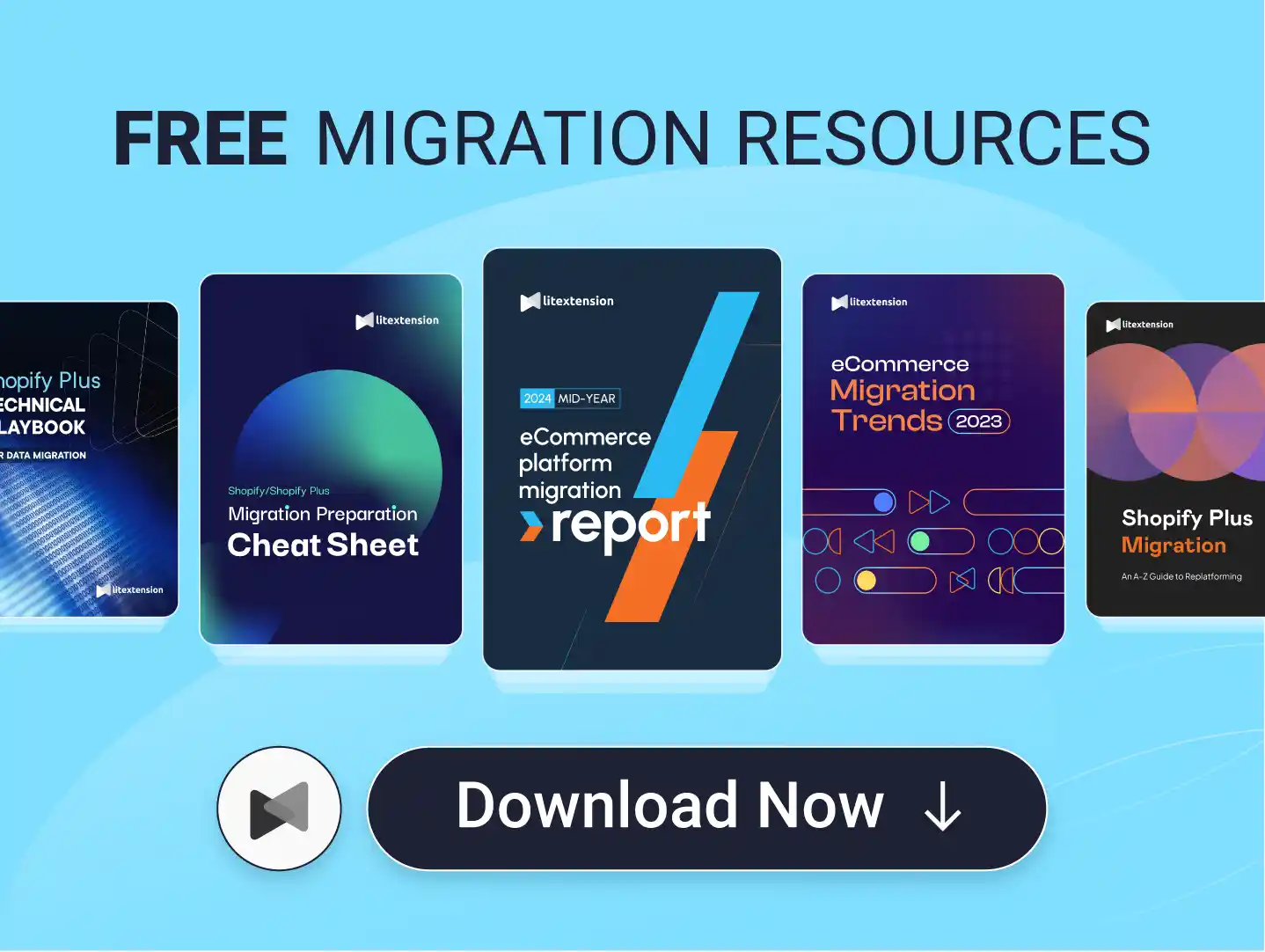It has been a well-established fact that numerous factors contribute to the success of an online store – and a reliable eCommerce order management system is definitely one of the most crucial criteria. After all, if orders aren’t handled efficiently, customers will be disappointed and less likely to return.
Yet, despite its importance, many merchants still aren’t clear on what order management in eCommerce actually does or how it works. Don’t worry; this guide will walk you through everything you need to know, including:
- An overview of the eCommerce order management system
- Features of an order management system
- How to choose the best system for your business
- 5 best order management systems for eCommerce
Let’s get started!
Key Takeaways
- An eCommerce order management system (OMS) is a centralized solution that manages the entire order lifecycle, from order placement and inventory updates to fulfillment, shipping, and customer communication.
- Core OMS features include centralized order visibility, real-time inventory synchronization, automated fulfillment workflows, intelligent order routing, analytics, and integrations with 3PLs and back-end systems.
- The best OMS for your business should align with your scale and operations, with key selection criteria including scalability, integration capabilities, real-time visibility, automation depth, and reporting tools.
- The 5 leading eCommerce OMS solutions are Shopify, Salesforce Order Management, Magento (Adobe Commerce) Order Management, BigCommerce, and QuickBooks Commerce.
eCommerce Order Management System: An Overview
An eCommerce order management system (OMS) is software that centralizes and automates the entire order lifecycle, from checkout to final delivery.
It works as a central control system that receives every incoming order, validates it against inventory and payment data, and then coordinates fulfillment by deciding where and how the order should be processed. As the order moves through picking, packing, and shipping, the system continuously updates inventory levels and order statuses in real-time across all sales channels.
What is eCommerce order management system?
An eCommerce order management system (OMS) is a digital solution that centralizes and automates the entire lifecycle of an online order, from the moment it is placed to the time it reaches the customer's doorstep.
Simply put, this order management system serves as the operational backbone of an eCommerce business, enabling sellers to track sales, monitor inventory, manage fulfillment, and maintain consistent communication across multiple channels. Furthermore, the OMS also eliminates manual processes and human error by streamlining order entry, allocation of resources, and real-time status updates.
How does OMS work?

Now that we've established what an order management system for eCommerce is, the next question is: how does it function in practice?
Behind the scenes, an OMS works as a central command center that coordinates multiple stages of the order process.
Specifically, once a customer places an order, the system automatically captures and stores the relevant data (such as product SKUs, quantities, shipping address, and payment status). It then verifies the order's validity and forwards it to the most appropriate fulfillment center, often based on inventory availability and the customer's location, to ensure the fastest delivery.
Simultaneously, the order management system adjusts inventory levels across all sales channels in real time to prevent overselling or stockouts. As the order moves through picking, packing, and shipping stages, the system continues to update statuses and generate necessary documentation, including shipping labels and invoices.
In addition, one of its most valuable roles is in customer communication. It automatically notifies the customer about the progress of their order to offer transparency and reassurance throughout the delivery journey. The entire process (from initial input to final mile tracking) happens within a single, integrated system that minimizes delays and improves service quality.
The benefits and challenges of order management in eCommerce
Understanding how an OMS works is crucial, but it's equally important to evaluate what it brings to the table and what obstacles might come with it.
The advantages of using a reliable order management system are extensive.
First and foremost, it significantly improves order accuracy by automating tasks that would otherwise be prone to human error. That alone can dramatically reduce issues like incorrect shipments and costly returns. It also optimizes fulfillment speed by automatically choosing the most efficient warehouse or fulfillment center for each order. Additionally, many OMS solutions are integrated with global shipping carriers, which allows businesses to access discounted rates and print shipping labels quickly and efficiently.
Another key advantage lies in centralization. By consolidating all orders into a unified dashboard, merchants gain full visibility and control, making it easier to avoid delays, prevent duplicate entries, and respond to customer inquiries more effectively. On the customer side, features like real-time order tracking and status notifications help build trust and reduce frustration. Furthermore, OMS tools can offer detailed insights into product performance and sales trends, which are invaluable for forecasting demand and preventing both overstocking and stockouts.
That said, deploying an OMS is not without its challenges.
One of the most common issues is integration. Many businesses still rely on legacy systems, and connecting these with a modern OMS can be complex and time-consuming, often leading to data mismatches or system delays. Scalability is another concern: some entry-level systems are simply not built to handle the rapid growth of a successful business, especially when it comes to handling international orders or high-volume spikes.
Finally, customization can be limited, as off-the-shelf OMS platforms may struggle to accommodate niche workflows. For instance, a business that manufactures made-to-order products or offers highly personalized goods may find it difficult to adapt these workflows to a rigid, pre-configured system.
Features of an eCommerce Order Management System
An eCommerce order management system typically includes 11 core features that work together to streamline order processing, fulfillment, and inventory control:
- Centralized order overview: This feature provides a single dashboard where all orders are collected and displayed in one place.
- Automated fulfillment workflows: Automated workflows handle repetitive order-related tasks without manual input.
- Intelligent fulfillment allocation: The OMS determines where each order should be fulfilled based on predefined logic such as inventory availability, customer location, or delivery speed.
- Bulk order management: This feature allows merchants to process large volumes of orders simultaneously.
- In-progress order modifications: Merchants can adjust order details before fulfillment begins if changes are requested.
- Flexible order drafting: Order drafting supports manual or custom sales outside the standard checkout flow.
- Inventory sync across channels: Inventory levels are updated automatically across all connected storefronts and warehouses.
- Live order performance metrics: Built-in analytics track order statuses such as new, fulfilled, delayed, or returned.
- Integrated 3PL connectivity: The OMS connects directly with third-party logistics providers to exchange order and tracking data.
- Back-end system integration (ERP): This feature links the OMS with enterprise systems like ERP or accounting software.
- Developer-friendly fulfillment APIs: APIs allow developers to extend or customize fulfillment logic beyond default workflows.
Feature | Description |
Centralized Order Overview | This all-in-one dashboard offers a clear and customizable view of every order in your system. Merchants can filter, search, tag, and add internal notes, which makes it easier to track delivery progress, flag delayed shipments, and prioritize fulfillment based on product type, destination, or status. |
Automated Fulfillment Workflows | By leveraging automation tools, merchants can set up workflows that handle repetitive tasks like triggering order fulfillment, updating inventory, or initiating returns. As a result, it reduces manual errors and makes fulfillment more consistent and scalable. |
Intelligent Fulfillment Allocation | Orders are automatically routed to the most suitable warehouse or third-party logistics (3PL) partner using rules based on location, inventory levels, or delivery estimates. |
Bulk Order Management | Designed for high-volume operations, this feature allows businesses to handle multiple orders at once. Users can generate and print shipping labels, packing slips, and customs forms in batches, which saves valuable time and minimizes friction during peak sales periods. |
In-Progress Order Modifications | Sometimes customers make changes after placing an order. This feature enables sellers to edit key details (such as product variants or shipping addresses) before fulfillment begins. |
Flexible Order Drafting | Ideal for manual sales or custom orders, the order drafting feature lets you create draft invoices that can be emailed to customers for payment, whether online or offline. It also supports more personalized or quote-based selling approaches outside the standard checkout flow. |
Inventory Sync Across Channels | Stock quantities are updated in real-time across all connected storefronts and warehouse locations. This prevents overselling, ensures accurate availability displays, and improves customer confidence in stock reliability. |
Live Order Performance Metrics | Built-in analytics give merchants instant access to order data, including new, open, fulfilled, and returned orders. These insights help identify delays and forecast future demand, paving the way for operational decision-making. |
Integrated 3PL Connectivity | Most OMS platforms support native or app-based integration with top third-party logistics providers. That way, orders, inventory levels, and tracking updates can flow smoothly between your store and external fulfillment partners. |
Back-End System Integration (ERP) | For medium to large businesses, this capability links the OMS to financial and operational systems, providing a full picture of orders, cash flow, procurement, and performance across departments. |
Developer-Friendly Fulfillment APIs | For brands with complex or custom fulfillment needs, APIs provide the freedom to build bespoke workflows. These tools enable precise control over even the most specialized logistics processes, from partial shipments to custom packaging. |
How to Choose the Best eCommerce Order Management System
An eCommerce order management system should be chosen based on how well it fits your current operations, using the 5 criteria below:
- Scalability: A strong OMS must support business growth without breaking existing workflows.
- Integration capabilities: Your OMS should integrate seamlessly with your existing eCommerce platform and back-end systems.
- Inventory and order visibility: Real-time visibility allows you to manage stock and orders with confidence.
- Automation features: Automation reduces manual effort and minimizes human error.
- Reporting and forecasting tools: Data-driven insights help guide operational decisions.
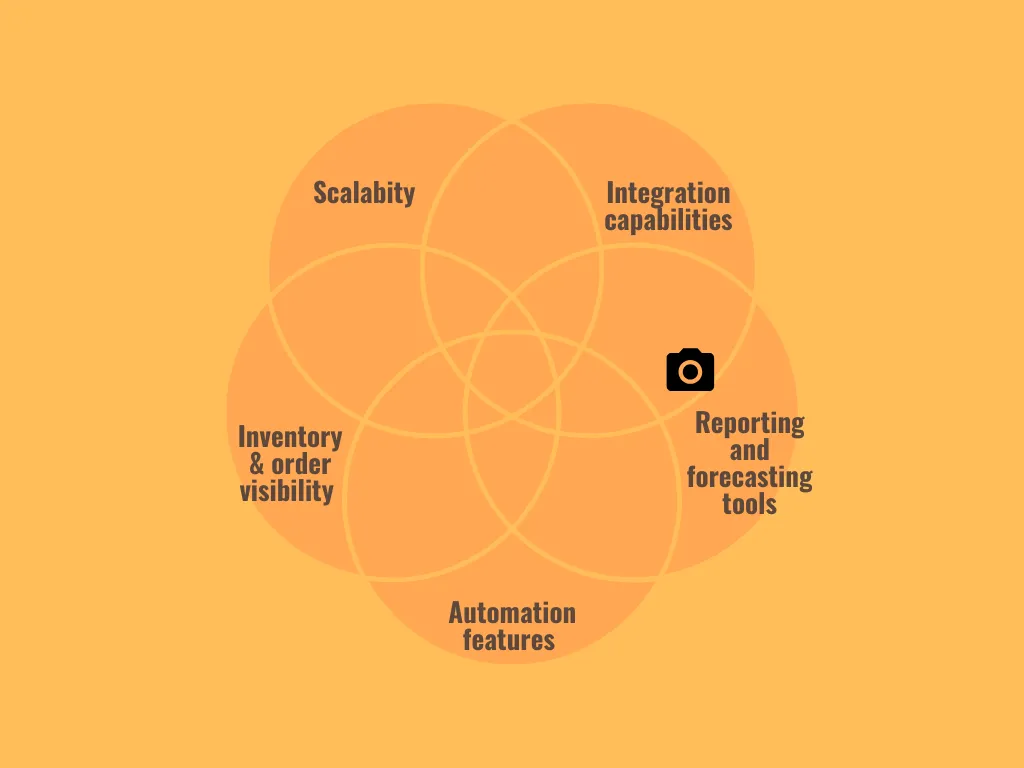
Scalability
Your OMS should be able to handle your business not only now but also in the future. Hence, we recommend looking for platforms that support multi-channel selling, multi-currency capabilities, international shipping, and distributed inventory management.
Integration capabilities
A modern OMS needs to fit seamlessly into your existing tech stack. This includes integration with your eCommerce platform, ERP, accounting software, warehouse management systems, customer service tools, and third-party logistics providers (3PLs).
Also, prioritize systems that offer robust native integrations or open APIs so you can customize workflows and ensure real-time data sync across all channels.
Inventory and order visibility
Real-time visibility into both inventory and orders is essential for smooth operations.
That's why your OMS should give you live updates on stock levels across all sales channels and fulfillment locations to avoid overselling or stockouts. It must also allow you to track every order from purchase to delivery, so you can respond quickly to issues like failed deliveries or delayed shipments.
Automation features
The best OMS platforms automate repetitive tasks to reduce manual labor and increase accuracy. Some outstanding examples include auto-routing orders to the right warehouse, generating shipping labels, triggering restock alerts, and handling returns or cancellations.
Reporting and forecasting tools
Lastly, a data-driven OMS must offer robust analytics and forecasting capabilities. That means not just showing you how many orders were placed, but providing insights into fulfillment speed, return rates, popular SKUs, seasonal trends, and customer behavior.
The Best eCommerce Order Management Systems
Here are 5 of the best eCommerce order management systems to consider:
- Shopify: A platform-native OMS fully embedded into the Shopify ecosystem.
- Salesforce Order Management: An enterprise-grade OMS built for high-volume, global, and omnichannel operations.
- Magento (Adobe Commerce) Order Management: A highly modular OMS solution tailored for businesses already using Magento or Adobe Commerce.
- BigCommerce: A scalable OMS approach that balances flexibility and usability without transaction fees.
- QuickBooks Commerce (formerly TradeGecko): A finance-first OMS focused on syncing orders and inventory with accounting workflows.
Shopify
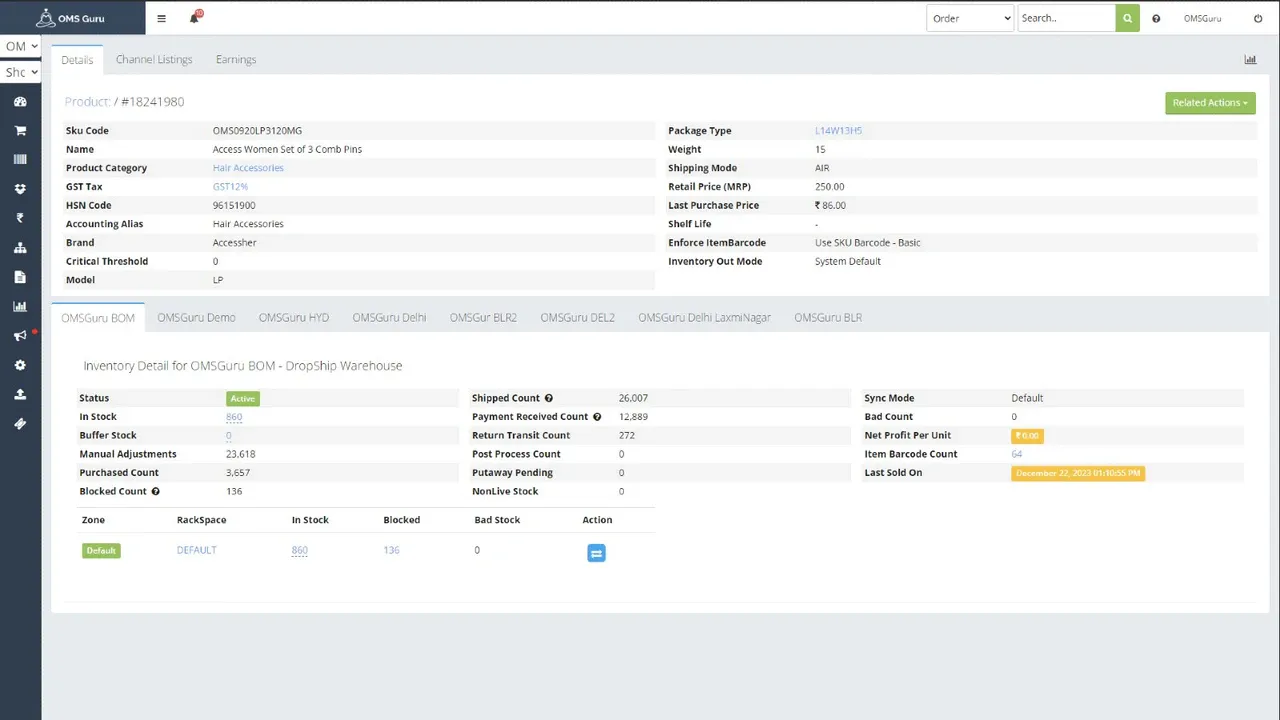
Building on broad OMS systems, Shopify excels with its natively integrated order management, particularly for merchants who prioritize both simplicity and automation. Its order management system is fully embedded into its eCommerce platform to ensure seamless workflows from order capture to delivery.
Features:
- Centralized order dashboard & automated workflows: Consolidates orders across online store, POS, and marketplaces with smart fulfillment rules and return handling.
- Real-time inventory sync & discounted shipping: Syncs stock across channels instantly, prevents overselling, and offers deeply discounted shipping labels up to 88% off
- Smooth returns and local pickup support: Built-in return flows and local delivery/pickup options help reduce friction.
Pricing:
- Basic: $39/month
- Grow (formerly Shopify): $105/month
- Advanced: $399/month
- Shopify Plus (Enterprise): Starts at around $2,300/month
Pros | Cons |
Deeply integrated OMS with automation and shipping discounts | Advanced features (e.g., flow automation) gated behind higher plans |
Excellent multi-channel support (online, in-store, marketplaces) | Add-on app costs can grow quickly for scale |
Easy to use with intuitive workflows | Less suited for highly customized or enterprise-grade use |
Read more: Shopify review
Salesforce Order Management
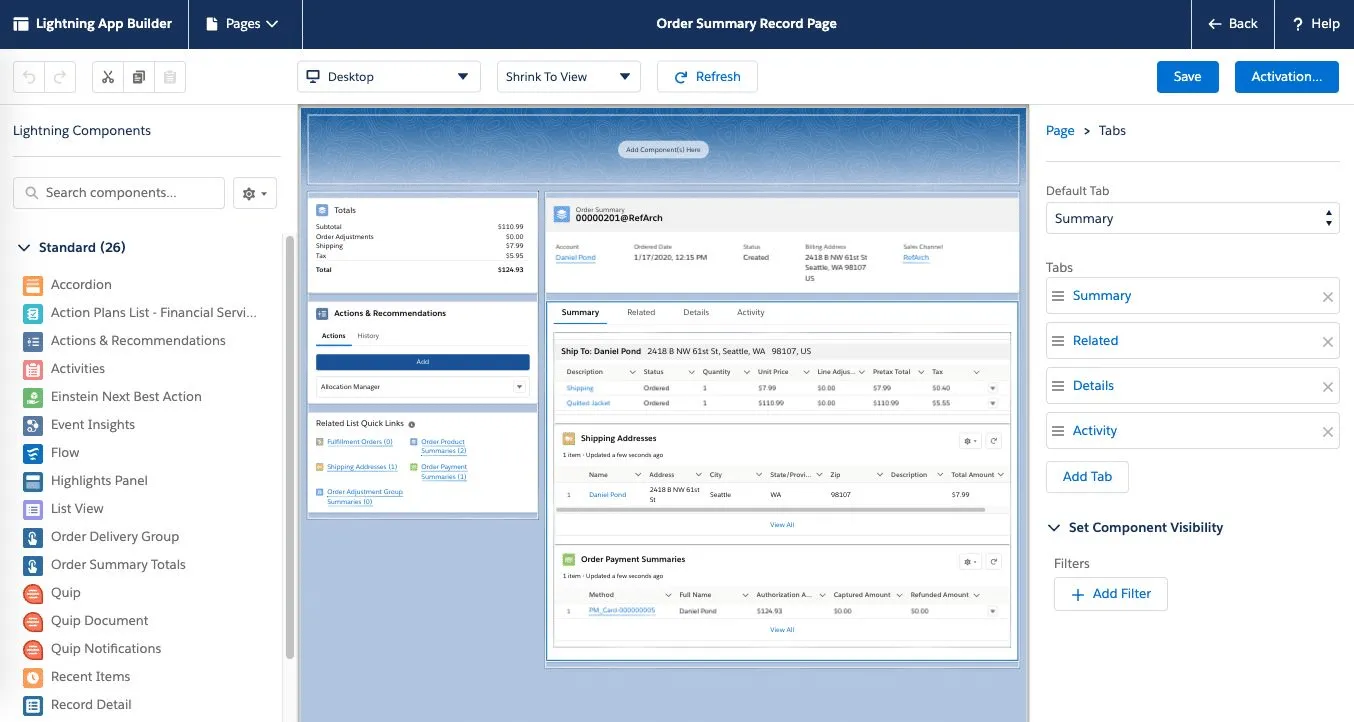
Unlike Shopify’s platform-first model, Salesforce OMS excels in enterprise-grade orchestration and global fulfillment, designed to handle high volume and complex logistics.
Features
- 360° order lifecycle & AI-driven orchestration: Supports end-to-end workflows including order capture, smart routing, global inventory visibility, billing, shipping, and returns
- Distributed inventory & localization: Manages stock across multiple locations (up to 500), with global standards and integration to Service Cloud
- Real-time visibility & automation: Automated fulfillment steps and instant tracking updates reduce errors and enhance service
Pricing
- Order Visibility: 0.25% of GMV per order
- Growth (full fulfillment engine): 1% of GMV per order
Pros | Cons |
Scalable for complex, global, omnichannel operations | Significant cost tied to order volume (GMV-based) |
AI-powered orchestration and distributed inventory | Typically requires heavy IT resources and enterprise investment |
Deep integration with CRM and Service Cloud | Overkill for SMBs |
Read more: Salesforce review
Magento (Adobe Commerce) Order Management
For those already within the Adobe/Magento ecosystem, the Magento order management delivers a highly modular, omnichannel solution designed for flexibility and extensibility.

Features:
- Extension-based advanced order editing: Tools like Mageworx let you edit orders, billing, shipping, and SKUs without cancellation
- Omni-channel order capture: Unifies orders from web, POS, dropship, and offline channels into a single system
- Inventory visibility across locations: Keeps real-time stock sync across multiple fulfillment centers
Pricing
Core OMS via Adobe Commerce license; full stack implementation often $4K+/year.
Pros | Cons |
Full customization via extensions & APIs | High implementation complexity and maintenance cost |
Ideal for Magento-based brands | Requires Magento developer expertise |
Strong omnichannel coverage | Pricing and solution components not all-in-one and semi-transparent |
Read more: Magento review
BigCommerce
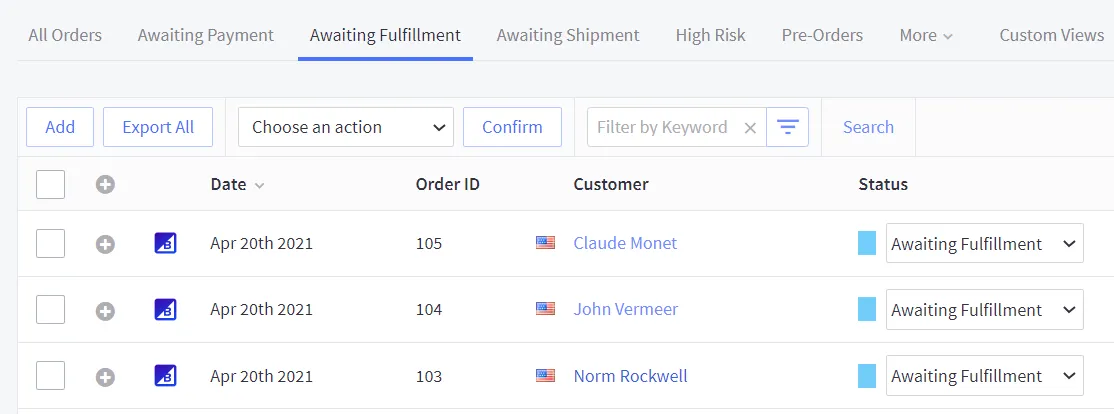
BigCommerce offers a scalable, no-transaction-fee order management that strikes a good balance between enterprise flexibility and SMB usability.
Features:
- Unified order pipeline & reporting: Centralized dashboard with stage-based status tracking and advanced reporting tools.
- Flexible fulfillment integrations: Works smoothly with 3PLs and apps like Order Desk for automated routing, zone or batch picking workflows
- Inventory management sync: Ensures stock is accurate across channels and warehouse locations
Pricing:
- Standard: $39/month
- Plus: $105/month
- Pro: $399/month (pricing increases above $400k annual revenue)
- Enterprise: Custom pricing (starts ~$1,000/month)
Pros | Cons |
Full customization via extensions & APIs | High implementation complexity and maintenance cost |
Ideal for Magento-based brands | Requires Magento developer expertise |
Strong omnichannel coverage | Pricing and solution components not all-in-one and semi-transparent |
Read more: BigCommerce review
QuickBooks Commerce (formerly TradeGecko)
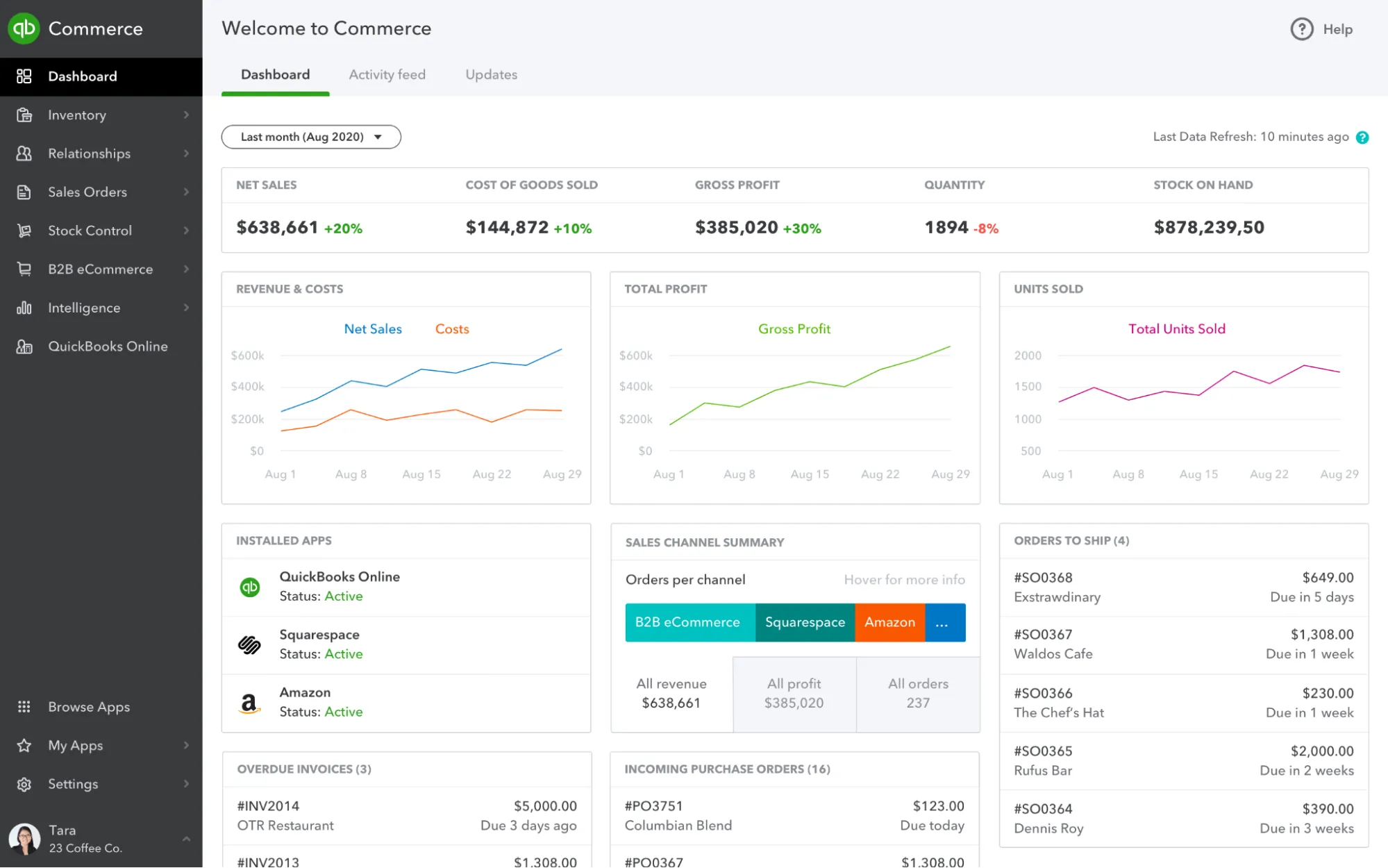
Coming from a finance-first approach, QuickBooks Commerce provides light yet functional OMS and inventory tools tightly connected to accounting.
Features:
- Channel-integrated order syncing: Pulls orders and payouts from Shopify, Amazon, eBay into QuickBooks for better finance oversight.
- Inventory control and order processing tools: Helps with multichannel stock management, creating purchase orders, and batch tracking
- Real-time analytics and forecasting: Business intelligence tools and demand forecasting integrate with accounting flows.
Pricing:
- Simple Start: $38/month
- Essentials: $75/month
- Plus: $115/month
- Advanced: $27.50/month
Pros | Cons |
Excellent integration between order management and accounting | Limited OMS functionality—no advanced fulfillment automation |
Affordable entry-level pricing | Less capable for high-volume or omnichannel operations |
User-friendly with financial controls | Scaling requires external logistics systems |
The Future of Multichannel Order Management 2026
1. Market situation and growth outlook
By 2026, multichannel order management will no longer be a niche optimization tool, but a structural requirement for businesses operating across multiple sales and fulfillment channels.
This shift is backed by clear market expansion: the global multichannel order management market is valued at USD 4.13 billion in 2025 and is projected to reach USD 4.53 billion in 2026, placing the category on a steady growth path toward USD 9.12 billion by 2034 at a 9.7% CAGR (Straitresearch).
Cloud deployment trends further reinforce this trajectory. In 2025, cloud-based OMS solutions accounted for 54.27% of total market share, signaling a structural preference for platforms that can scale quickly, integrate easily, and support real-time coordination across channels (Straitresearch).

Simply put, in 2026, flexibility and speed of deployment will likely outweigh traditional on-premises control for most commerce-driven organizations, particularly in retail and eCommerce environments.
2. Advantages driving OMS adoption
The most significant advantage of multichannel order management is operational unification. By consolidating order capture, inventory visibility, and fulfillment orchestration into a single system, businesses can eliminate channel-level silos that traditionally lead to overselling, delayed shipments, and inconsistent customer experiences. This unified approach allows companies to allocate inventory more intelligently and fulfill orders from the most efficient location.
Another major driver is the ability to meet rising customer expectations. By 2026, fast delivery, flexible pickup options, accurate order tracking, and seamless returns will be standard expectations rather than differentiators. A robust OMS enables businesses to support these experiences consistently across all channels, whether the order originates from an online store, a marketplace, or a physical location. As a result, OMS platforms directly contribute to higher customer satisfaction and long-term retention.
Additionally, advanced analytics and automation capabilities are becoming central to OMS value. Modern systems provide actionable insights into fulfillment performance, demand patterns, and inventory turnover, all of which enable data-driven decision-making. Automation further reduces reliance on manual processes, meaning businesses can scale order volumes without a proportional increase in operational costs or staffing.
3. Challenges shaping the future
On the other hand, despite its benefits, multichannel order management faces growing challenges that will shape its evolution by 2026.
One of the most pressing issues is data governance and localization. As governments introduce stricter regulations around customer data storage and cross-border data flows, businesses operating in multiple regions must adapt their OMS architectures to remain compliant. This often increases infrastructure complexity and operational overhead.
Integration complexity is another persistent challenge, particularly for organizations with legacy systems or fragmented technology stacks. Connecting an OMS with ERP, CRM, warehouse systems, and third-party logistics providers requires careful planning and ongoing maintenance. Without a well-structured integration strategy, businesses risk data inconsistencies, delayed updates, and system instability as they scale.
Finally, there is an ongoing tension between standardization and flexibility. Though automation and predefined workflows improve efficiency, overly rigid OMS platforms can struggle to support niche fulfillment models, customized products, or region-specific processes.
In short, by 2026, successful OMS solutions will need to strike a balance. It needs to offer robust automation and scalability while still allowing enough configurability to adapt to diverse business models.
eCommerce Order Management: FAQs
What is eCommerce order management?
eCommerce order management refers to the end-to-end process of receiving, tracking, fulfilling, and servicing customer orders placed online.
It includes order capturing from various sales channels (such as websites, marketplaces, or POS), inventory updates, payment processing, shipment handling, return management, and customer notifications. The goal is to ensure each order is fulfilled accurately, on time, and in a way that meets or exceeds customer expectations.
What is the difference between OMS and CRM?
An OMS (Order Management System) manages the operational side of fulfilling and tracking customer orders, handling tasks like inventory synchronization, shipping logistics, and returns.
In contrast, a CRM (Customer Relationship Management) system focuses on managing customer interactions, communication, support, and data such as contact info and service history.
In short, OMS supports the logistics of a transaction, while CRM supports the relationship behind it.
What is an OMS in eCommerce?
In eCommerce, an OMS (Order Management System) is a software solution that centralizes and automates the entire order lifecycle. It enables online retailers to process orders from multiple channels (e.g., website, marketplaces, in-store), manage inventory in real time, route orders to appropriate fulfillment centers, generate shipping labels, track delivery statuses, and process returns or exchanges.
Which OMS is best?
The “best” OMS depends on your business needs, size, and technical setup.
- Shopify is ideal for small to mid-sized merchants looking for an all-in-one solution with native OMS tools.
- Salesforce OMS is powerful for enterprise businesses needing global orchestration and advanced automation.
- Magento OMS suits companies requiring deep customization and omnichannel capabilities.
- BigCommerce offers a solid, affordable OMS setup with no transaction fees, suitable for growing businesses.
- QuickBooks Commerce is best for small businesses that want basic order management with built-in accounting.
Each platform has strengths depending on your complexity, fulfillment model, and growth plans.
Final Words
All in all, a strong eCommerce order management system is the engine that keeps your entire operation running smoothly. Choosing the right solution can make a world of difference for your business, whether you’re just starting out or looking to optimize your existing workflows!
And if you’re planning to migrate to a new platform to take full advantage of a better order management system, LitExtension is here to help. With over 12 years of experience and a proven track record serving 200,000+ merchants, we can ensure your migration is smooth, secure, and completely free of data loss.
For more information, check out our blog and join our Facebook Community.
